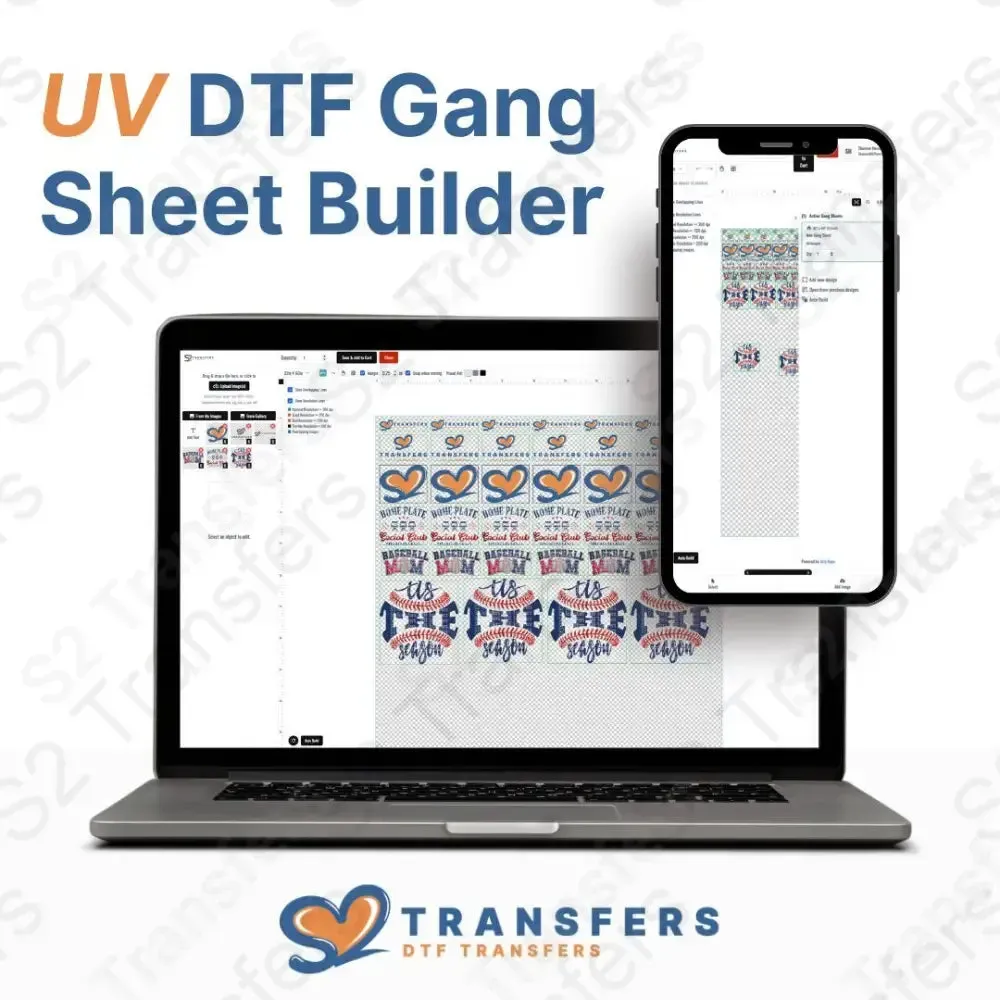The UV DTF Gangsheet Builder stands at the forefront of modern printing technology, revolutionizing the way designs are transferred onto various substrates. By allowing multiple designs to be printed on a single sheet, this innovative tool not only maximizes efficiency but also minimizes material waste—making it an essential component for any printing professional. In this comprehensive guide, we’ll explore essential UV printing tips and DTF printing best practices to help you master the art of gangsheet printing. Whether you’re new to transfer film printing or looking to refine your skills, understanding the nuances of this technology will elevate your print quality significantly. Join us as we delve into expert insights that will empower you to create stunning printed products that meet industry standards.
Exploring the capabilities of the UV DTF Gangsheet Builder reveals a myriad of opportunities for both novice and experienced printers alike. This groundbreaking approach to direct-to-film printing not only enhances the workflow but also aligns with the latest trends in printing technology. Utilizing a gangsheet method simplifies the process of transferring intricate designs onto fabrics and other materials, ensuring optimal outputs and reduced production costs. In this article, we aim to provide readers with a detailed overview of essential practices for successful DTF printing while offering tips and tricks to maximize your results. From selecting the right materials to mastering the printing process, we cover all aspects of utilizing this advanced printing technology.
Understanding the Basics of UV DTF Printing Technology
UV DTF printing technology represents a groundbreaking shift in the print industry, delivering high-quality and durable prints on various materials. This process involves printing designs directly onto a transfer film, which is then cured using specialized UV light. By offering a quick and efficient way to produce intricate designs, UV DTF has proven to be essential for businesses looking to maximize their print capabilities. As a user, understanding the fundamentals of this technology is critical to ensuring you achieve the desired artistic outcome.
Moreover, the versatility of UV DTF technology is notable, allowing for a broad range of applications across fabrics, plastics, and more. This adaptability is one reason why many designers and print professionals are drawn to this method. As the industry continues to innovate, staying ahead with UV printing tips and best practices ensures that you can harness the full potential of this technology in your projects.
Key Insights into Using the UV DTF Gangsheet Builder
The UV DTF Gangsheet Builder stands out as an indispensable tool for printing multiple designs on a single sheet, maximizing production efficiency while minimizing waste. This tool is particularly beneficial for those producing bulk orders or limited runs of various designs. By organizing your graphics effectively, you can ensure each print adheres properly without sacrificing quality, making the gangsheet builder a must-have for serious print professionals.
Furthermore, utilizing the Gangsheet Builder not only streamlines workflows but also allows for creative freedom in design placement. Whether you’re experimenting with color gradations or intricate patterns, the builder supports a range of artistic expressions. When combined with DTF printing best practices, you can achieve stunning results that showcase the capabilities of the UV DTF system.
Essential Printer Setup for Optimal Results
Setting up your printer correctly is fundamental to achieving optimal results in UV DTF printing. Adjusting color profiles and resolution settings tailored to your specific printer model can significantly enhance the print quality. Ensuring that your printer is calibrated accurately helps reduce common pitfalls such as color mismatches and pixelation, which can detract from the final product.
Moreover, compatibility with your printing software is critical in avoiding production errors. It’s essential to choose software that supports not only gangsheet production but also the nuances of UV printing technology. By investing the time to optimize your printer settings and software compatibility, you will minimize errors and waste, allowing for a more effective printing process.
Design Considerations for Effective Gangsheet Printing
When preparing designs for the UV DTF Gangsheet Builder, specific design considerations can influence the final print quality. Utilizing vector graphics is highly recommended, as they allow for resizing without quality loss, making them ideal for various gangsheet dimensions. Additionally, accounting for bleed areas in your designs ensures that no critical design elements are cropped during the transfer process.
Incorporating these design strategies not only enhances print accuracy but also contributes to professional-looking results. Utilizing design software effectively, such as Adobe Illustrator, can further ensure your graphic elements are perfectly tailored for UV DTF printing, creating prints that stand out and meet high customer expectations.
Choosing the Right Materials for UV DTF Printing
The quality of the materials you use directly impacts the vibrancy and durability of your prints. Selecting the right transfer films is crucial, as high-quality materials specifically designed for UV printing will yield better results. Investing in premium transfer papers often pays off with richer colors and longer-lasting prints, which can be a significant advantage in a competitive market.
Additionally, testing different substrates is essential for understanding how each interacts with your UV inks. Each material behaves differently, and conducting print tests can help you identify the combination that delivers the best adhesion and color fidelity. Ultimately, the right material choice lays the foundation for superior print quality.
Post-Printing Curing Techniques for Longevity
Post-printing curing is a critical stage that cannot be overlooked in the UV DTF printing process. Adhering to specified curing times ensures that the inks solidify correctly, enhancing the durability of your print outputs. Each ink-substrate combination may have unique requirements, which is why following manufacturer guidelines is essential to avoid potential issues with adhesion and print longevity.
Proper handling during the curing phase is equally important; keeping your prints out of direct sunlight and humidity will protect them before they are fully cured. By implementing these best practices, you can ensure that your prints maintain their quality over time, further solidifying your reputation for excellence in the printing industry.
Frequently Asked Questions
What is the UV DTF Gangsheet Builder and how does it work?
The UV DTF Gangsheet Builder is a specialized tool in UV printing technology that allows users to print multiple designs on a single film sheet. This process involves printing designs onto transfer film using UV inks, curing them for durability, and then transferring the images onto various substrates. By understanding its workflow, users can effectively reduce waste and enhance efficiency in their printing projects.
What are the best practices for UV DTF printing with the Gangsheet Builder?
To achieve optimal results using the UV DTF Gangsheet Builder, ensure your printer is properly calibrated with the right color profiles and high-resolution settings. Incorporate vector graphics into your designs and use quality transfer films. Conduct print tests to perfect ink density and follow manufacturer guidelines for curing times to enhance print durability.
How can I improve my designs for the UV DTF Gangsheet Builder?
Improving your designs for the UV DTF Gangsheet Builder involves using vector graphics that are scalable and incorporating bleed areas to prevent cropping. Additionally, using design software like Adobe Illustrator can enhance your graphic creation, ensuring compatibility with gangsheet printing requirements, leading to better overall print quality.
What substrates are best for UV DTF gangsheet printing?
Selecting the right substrate is essential for vibrant prints when using the UV DTF Gangsheet Builder. High-quality transfer papers specifically designed for UV printing are recommended. Conduct tests on various materials to find which substrate works best with your UV inks for ensuring strong adhesion and color fidelity.
What tips can I follow for optimizing ink usage with the UV DTF Gangsheet Builder?
To optimize ink usage with the UV DTF Gangsheet Builder, adjust your ink density settings carefully to balance clarity with saturation. Always perform print tests to find the right ink levels that prevent issues such as bleeding and smudging while achieving vivid colors.
How do I ensure effective curing of prints made with the UV DTF Gangsheet Builder?
Effective curing of prints made with the UV DTF Gangsheet Builder requires following the manufacturer’s guidelines for curing times and conditions. Ensure that printed sheets are stored properly away from sunlight or moisture until they are fully cured, as this protects the print quality and strengthens adhesion.
| Key Point | Details |
|---|---|
| Understanding the UV DTF Printing Process | Involves printing, curing, and transferring designs onto substrates using specialized inks. |
| Proper Printer Setup | Ensure correct color profiles, high-resolution settings, and software compatibility. |
| Design Tips for Better Outcomes | Use vector graphics with bleed areas to ensure perfect transfer and scalability. |
| Selecting the Right Materials | Choose high-quality transfer papers and conduct substrate tests for compatibility. |
| Optimize Ink Usage | Adjust ink density settings and conduct print tests to refine quality. |
| Handling Post-Printing Curing | Follow curing times and store sheets properly before curing. |
| Streamlining Workflow with Software | Use compatible software to enhance efficiency and reduce errors. |
Summary
The UV DTF Gangsheet Builder is a powerful tool for modern printing, enabling users to produce high-quality prints with efficiency and minimal waste. By mastering the UV DTF printing process, setting up your printer correctly, and selecting the right materials, users can achieve vibrant designs that last. Additionally, focusing on design elements and optimizing ink usage are crucial for enhancing print quality. Utilizing the right software can further streamline operations, making the printing process more effective. Overall, the UV DTF Gangsheet Builder empowers professionals to create stunning prints that meet industry standards.

